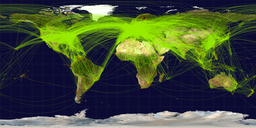
Back طيران مدني Arabic Mülki aviasiya Azerbaijani Грамадзянская авіяцыя Byelorussian Гражданска авиация Bulgarian বেসামরিক বিমান চলাচল Bengali/Bangla Civilna avijacija BS Civilní letectví Czech Zivile Luftfahrt German Πολιτική αεροπορία Greek هوانوردی غیرنظامی Persian

Civil aviation is one of two major categories of flying, representing all non-military and non-state aviation, both private and commercial. Most countries in the world are members of the International Civil Aviation Organization and work together to establish common Standards and Recommended Practices for civil aviation through that agency.
Civil aviation includes three major categories:
- Commercial air transport, including scheduled and non-scheduled passenger and cargo flights
- Aerial work, in which an aircraft is used for specialized services such as agriculture, photography, surveying, search and rescue, etc.
- General aviation (GA), including all other civil flights, private or commercial[1]
Although scheduled air transport is the larger operation in terms of passenger numbers, GA is larger in the number of flights (and flight hours, in the U.S.[2]) In the U.S., GA carries 166 million passengers each year,[3] more than any individual airline, though less than all the airlines combined. Since 2004, the U.S. airlines combined have carried over 600 million passengers each year, and in 2014, they carried a combined 662,819,232 passengers.[4]
Some countries[which?] also make a regulatory distinction[citation needed] based on whether aircraft are flown for hire, like:
- Commercial aviation includes most or all flying done for hire, particularly scheduled service on airlines; and
- Private aviation includes pilots flying for their own purposes (recreation, business meetings, etc.) without receiving any kind of remuneration.

All scheduled air transport is commercial, but general aviation can be either commercial or private. Normally, the pilot, aircraft, and operator must all be authorized to perform commercial operations through separate commercial licensing, registration, and operation certificates.
Non-civil aviation is referred to as state aviation. This includes military aviation, state VIP transports, and police/customs aircraft.[5]
- ^ "1. Definitions" (PDF). Annex 6, Operation of Aircraft Part I, International Commercial Air Transport – Aeroplanes (9 ed.). International Civil Aviation Organization (ICAO). July 2010. pp. 1, 3 and 5. ISBN 9789292315368. Retrieved 17 March 2019.
- ^ "NTSB - Aviation Accident Statistics". Archived from the original on 2009-09-01. Retrieved 2009-08-16.
- ^ "Advantages of General Aviation vs. Airline, Faster, Better, Cheaper, More Secure". Archived from the original on 2008-09-13. Retrieved 2008-09-03.
- ^ United States Department of Transportation. "Bureau of Transportation Statistics Archived 2015-07-25 at the Wayback Machine". Retrieved 24 July 2015
- ^ iaopa.org, "What is GA?" Archived 20 December 2016 at the Wayback Machine. Retrieved 10 October 2021